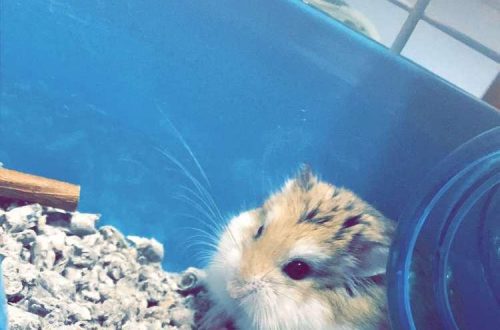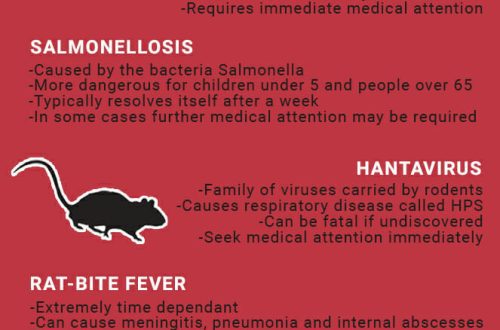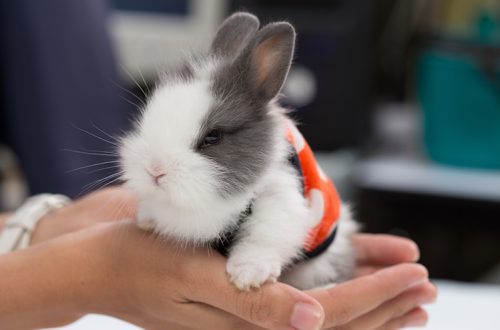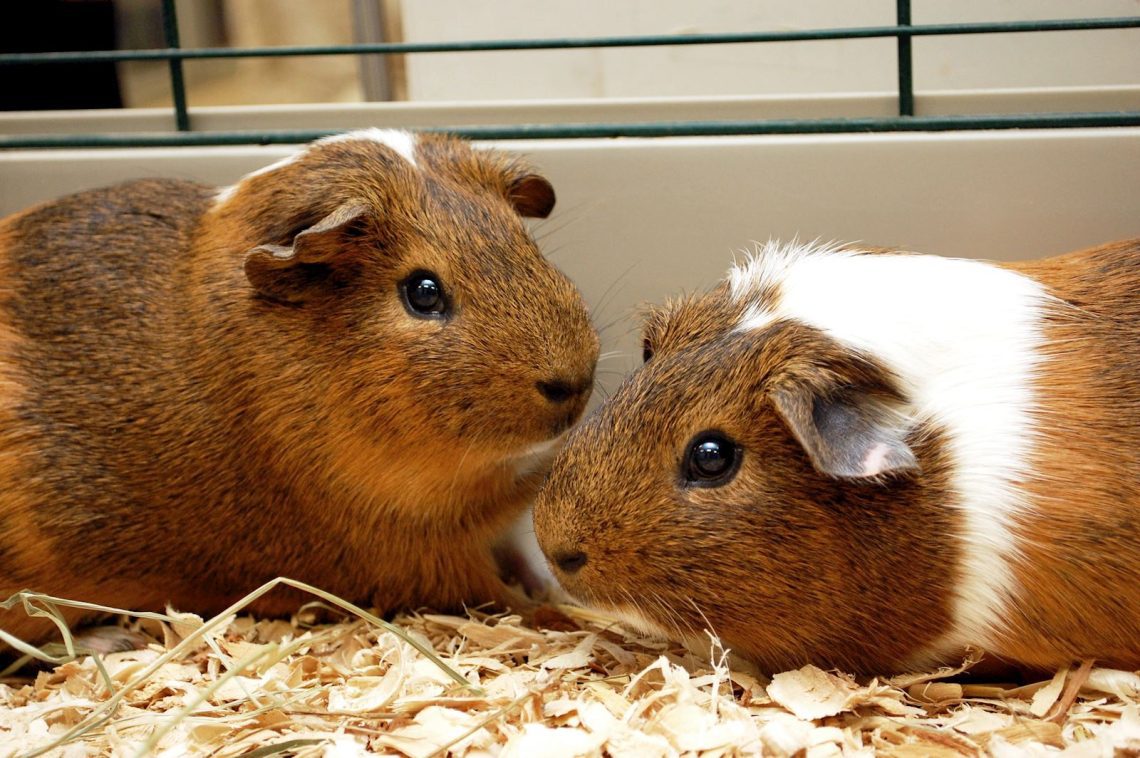
Papillottes for guinea pigs
For more information on grooming long haired guinea pigs, see the article on grooming long haired guinea pigs.
Papillottes are usually pieces of rubber band and cork paper or a piece of plain kitchen towel in which strands of wool are placed and secured with an elastic band. Young pigs (up to three months old) require only one curl on the train (wool around the buttocks). Older pigs also need side curlers. They are an essential part of your show success as they keep the coat from getting damaged and drying out. The only thing you can’t say about them is that they are cruel! This is much better than if they run around, dragging luxurious strands over sawdust, trampling and soiling them. Most guinea pigs don’t mind having their hair constantly twisted and untwisted, anyway they could always pluck or comb it if they didn’t like it very much. Some gilts take a long time to get used to this operation, but in any case, sooner or later they will get used to it anyway. Below are diagrams of how to properly remove wool in hairpins:
For more information on grooming long haired guinea pigs, see the article on grooming long haired guinea pigs.
Papillottes are usually pieces of rubber band and cork paper or a piece of plain kitchen towel in which strands of wool are placed and secured with an elastic band. Young pigs (up to three months old) require only one curl on the train (wool around the buttocks). Older pigs also need side curlers. They are an essential part of your show success as they keep the coat from getting damaged and drying out. The only thing you can’t say about them is that they are cruel! This is much better than if they run around, dragging luxurious strands over sawdust, trampling and soiling them. Most guinea pigs don’t mind having their hair constantly twisted and untwisted, anyway they could always pluck or comb it if they didn’t like it very much. Some gilts take a long time to get used to this operation, but in any case, sooner or later they will get used to it anyway. Below are diagrams of how to properly remove wool in hairpins:
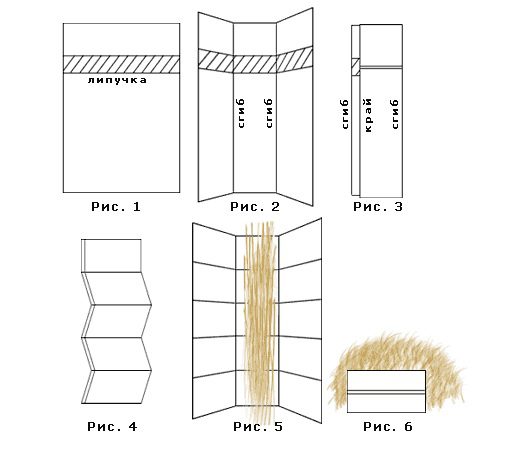
Heather J. Henshaw, England
Heather J. Henshaw, England
Contents
Explanations to the diagrams from Alexandra Belousova
Velcro is sewn onto a rag (or towel, about which the author of this article wrote). This is done from one end of the sheet along its width (Fig. 1, 2). The sheet is then folded as shown in Fig. 2. That is, you should get two folds and three faces. Then the structure is rolled up and one long edge is obtained and then it is further compressed along the entire length with an accordion (Fig. 4). Then the whole sheet is unfolded and therefore it turns out so many folds on it! (Fig. 5). Then they unfold everything, remove the wool there, on one side of the Velcro sheet so that the hair does not come out. The sheet is first folded along, as if long flaps are slammed, and then, in order to make it convenient to put on an elastic band, they are folded in width along the prepared folds. At the end, a compact pocket is obtained, and it is this that is tied with an elastic band (Fig. 6).
I will share my own experience on how to make papillots.
In this short article, I will try to tell you how to make papillots for pigs, based on numerous articles and drawings provided by our English colleagues, as well as on my own experience.
In the beginning, a little about what English breeders say about this. When winding papillots, they use paper or an ordinary towel, which are folded according to a certain system.
For a long time I tried to use improvised means for winding papillots, however, slightly different from those proposed in the article. Instead of regular paper, I took a sheet of specially curly paper designed for dogs. This is rice paper, which is much softer and stronger than ordinary paper, and can be used more than once. To make rubber bands, you can use an ordinary balloon by cutting it into many small strips, and if necessary, they can be cut again, since this material stretches very well. But you can also buy special little rubber bands for hairpins, which, like rice paper, are sold at dog shows. It is also possible to change the paper folding pattern depending on the length of the pig’s hair, as well as change the size of the sheet used, and for hygienic preservation of regrown wool, you can also use ordinary human hair ties, however, the smallest ones. Wool can be collected in ponytails on different parts of the body, or tied one at the back. But provided that you want to grow a real show pig, then you must use the first option proposed, since others are very unreliable and cannot guarantee excellent hair preservation.
Good luck in this difficult task!
Velcro is sewn onto a rag (or towel, about which the author of this article wrote). This is done from one end of the sheet along its width (Fig. 1, 2). The sheet is then folded as shown in Fig. 2. That is, you should get two folds and three faces. Then the structure is rolled up and one long edge is obtained and then it is further compressed along the entire length with an accordion (Fig. 4). Then the whole sheet is unfolded and therefore it turns out so many folds on it! (Fig. 5). Then they unfold everything, remove the wool there, on one side of the Velcro sheet so that the hair does not come out. The sheet is first folded along, as if long flaps are slammed, and then, in order to make it convenient to put on an elastic band, they are folded in width along the prepared folds. At the end, a compact pocket is obtained, and it is this that is tied with an elastic band (Fig. 6).
I will share my own experience on how to make papillots.
In this short article, I will try to tell you how to make papillots for pigs, based on numerous articles and drawings provided by our English colleagues, as well as on my own experience.
In the beginning, a little about what English breeders say about this. When winding papillots, they use paper or an ordinary towel, which are folded according to a certain system.
For a long time I tried to use improvised means for winding papillots, however, slightly different from those proposed in the article. Instead of regular paper, I took a sheet of specially curly paper designed for dogs. This is rice paper, which is much softer and stronger than ordinary paper, and can be used more than once. To make rubber bands, you can use an ordinary balloon by cutting it into many small strips, and if necessary, they can be cut again, since this material stretches very well. But you can also buy special little rubber bands for hairpins, which, like rice paper, are sold at dog shows. It is also possible to change the paper folding pattern depending on the length of the pig’s hair, as well as change the size of the sheet used, and for hygienic preservation of regrown wool, you can also use ordinary human hair ties, however, the smallest ones. Wool can be collected in ponytails on different parts of the body, or tied one at the back. But provided that you want to grow a real show pig, then you must use the first option proposed, since others are very unreliable and cannot guarantee excellent hair preservation.
Good luck in this difficult task!
Step-by-step scheme for winding papillots for guinea pigs
Due to the fact that many people have difficulties in caring for long-haired pigs, and also because very few people have the practice of using curlers, and the pictures and diagrams presented on our website cannot convey all the nuances, in view of all this, we we decided to try to write another auxiliary article about how to properly care for the luxurious wool of shelties, Peruvian pigs, texels, coronets, etc. In order to make the whole procedure easier to imagine, we decided to take a series of photographs that will clearly demonstrate all the stages of removing wool into hairpins. So let’s get started!
- In order to learn how to tie papillots correctly, you need to prepare all the necessary things – a long-haired pig (preferably older than three months, since at a younger age the wool is not long enough), a sheet or two of thin soft paper (you can use rice paper or plain white paper of the format A4), a few thin rubber bands (if there are no special rubber bands, you can cut them from an ordinary balloon), as well as a lot of patience!
Due to the fact that many people have difficulties in caring for long-haired pigs, and also because very few people have the practice of using curlers, and the pictures and diagrams presented on our website cannot convey all the nuances, in view of all this, we we decided to try to write another auxiliary article about how to properly care for the luxurious wool of shelties, Peruvian pigs, texels, coronets, etc. In order to make the whole procedure easier to imagine, we decided to take a series of photographs that will clearly demonstrate all the stages of removing wool into hairpins. So let’s get started!
- In order to learn how to tie papillots correctly, you need to prepare all the necessary things – a long-haired pig (preferably older than three months, since at a younger age the wool is not long enough), a sheet or two of thin soft paper (you can use rice paper or plain white paper of the format A4), a few thin rubber bands (if there are no special rubber bands, you can cut them from an ordinary balloon), as well as a lot of patience!
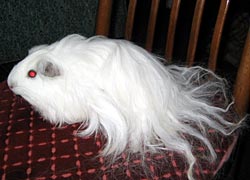
- It is necessary to cut out a not very wide strip from paper (about 6 cm wide). The length of the strip should be equal to the length of the hair on the part of the body where this hairpin will be located. If, for example, the length of the wool on the side is 10 cm, then the strip of paper should be 10-11 cm. If the length of the wool is 15 cm at the back, then the back papillot should also be 15-16 cm long. Subsequently, the length of the paper strips should be increased in proportion to hair growth.
Next, the cut out strip of paper must be folded lengthwise, forming three equal faces (each 3 cm wide).
- It is necessary to cut out a not very wide strip from paper (about 6 cm wide). The length of the strip should be equal to the length of the hair on the part of the body where this hairpin will be located. If, for example, the length of the wool on the side is 10 cm, then the strip of paper should be 10-11 cm. If the length of the wool is 15 cm at the back, then the back papillot should also be 15-16 cm long. Subsequently, the length of the paper strips should be increased in proportion to hair growth.
Next, the cut out strip of paper must be folded lengthwise, forming three equal faces (each 3 cm wide).
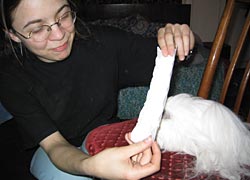
- After the paper papilot is prepared, it is necessary to select a small strand from the entire mass of the pig’s hair, separate it from the rest of the wool, tangled unnecessary hairs and smooth it.
- After the paper papilot is prepared, it is necessary to select a small strand from the entire mass of the pig’s hair, separate it from the rest of the wool, tangled unnecessary hairs and smooth it.

Take the prepared strip of paper in your hand and carefully place the selected strand of hair in the middle (on the middle edge), then wrap one side edge, making sure that not a single hair is knocked out.
Take the prepared strip of paper in your hand and carefully place the selected strand of hair in the middle (on the middle edge), then wrap one side edge, making sure that not a single hair is knocked out.
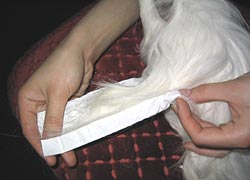
Then wrap the second side edge. Thus, it turns out that all the wool is placed in a kind of paper pocket. Be careful and careful – each papillot should be as close as possible to the body of the pig, should (if possible) start from the very root of the hair. As a result, the curl will be tight and the hair will not be knocked out or tangled.
Then wrap the second side edge. Thus, it turns out that all the wool is placed in a kind of paper pocket. Be careful and careful – each papillot should be as close as possible to the body of the pig, should (if possible) start from the very root of the hair. As a result, the curl will be tight and the hair will not be knocked out or tangled.
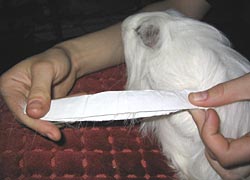
Then you need to try to fold the resulting pocket with wool several times in width. There can be as many turns as you like, it all depends on the length of the wool – if it is short, then you will get no more than one or two turns, if it is long – five, ten, fifteen …
To make it easier to fold a sheet of paper, it is best if you fold your empty sheet of paper in the required sequence before removing the wool, since directly during the winding procedure, the paper (especially if it is ordinary writing paper) may not obey, and in as a result, the proper ordering of the wool inside the hairpin will be violated.
Then you need to try to fold the resulting pocket with wool several times in width. There can be as many turns as you like, it all depends on the length of the wool – if it is short, then you will get no more than one or two turns, if it is long – five, ten, fifteen …
To make it easier to fold a sheet of paper, it is best if you fold your empty sheet of paper in the required sequence before removing the wool, since directly during the winding procedure, the paper (especially if it is ordinary writing paper) may not obey, and in as a result, the proper ordering of the wool inside the hairpin will be violated.
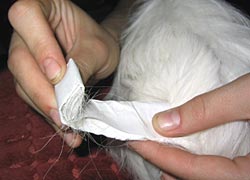
It looks like a fully twisted papillot. It should be as tight as possible and fit snugly against the body of the pig.
It looks like a fully twisted papillot. It should be as tight as possible and fit snugly against the body of the pig.
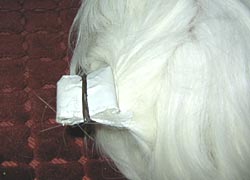
Next, on the resulting paper pocket, you need to put on the prepared rubber band, making a few turns. The elastic should be wrapped very tightly so that the papilot cannot slip off.
Next, on the resulting paper pocket, you need to put on the prepared rubber band, making a few turns. The elastic should be wrapped very tightly so that the papilot cannot slip off.
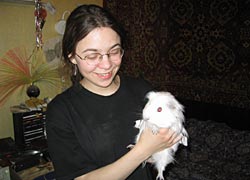
Repeat the procedure several times, so that each strand of hair has a papillot. As a rule, one is worn in the back, and one or two or three on each side. You can also wear a papillot on the neck, if the length of the hair allows.
Provided that everything was done correctly, the pig will not try to tear off the pieces of paper, but will sit quite calmly in the cage and go about its pig business. And the owner at this time may not worry at all that his pig will stain his luxurious wool.
But it must be remembered that the effect of using papillots will only be if they are changed DAILY!!!
Patience, patience and more patience!
© Alexandra Belousova
Repeat the procedure several times, so that each strand of hair has a papillot. As a rule, one is worn in the back, and one or two or three on each side. You can also wear a papillot on the neck, if the length of the hair allows.
Provided that everything was done correctly, the pig will not try to tear off the pieces of paper, but will sit quite calmly in the cage and go about its pig business. And the owner at this time may not worry at all that his pig will stain his luxurious wool.
But it must be remembered that the effect of using papillots will only be if they are changed DAILY!!!
Patience, patience and more patience!
© Alexandra Belousova



